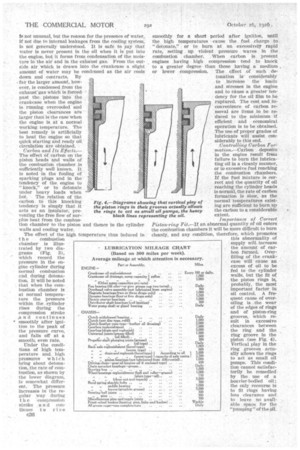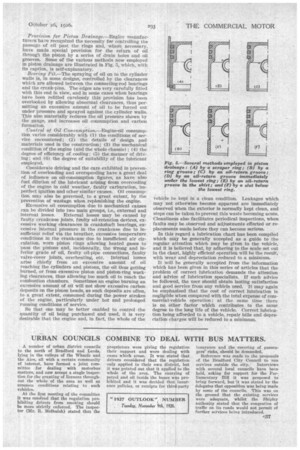AVOIDING WASTE IN LUBRICATION.
Page 57

Page 58

Page 59

If you've noticed an error in this article please click here to report it so we can fix it.
The Fifth and Concluding Article of a Useful Series Dealing with the Problem of Correct and Economical Lubrication.
IN the fourth of this series of articles on vehicle lubrication, published in last week's issue of The Commercial Motor, we partly discussed the question of the maintenance of a lubricating system to ensure that it should remain in such a condition that, good and suitable oil having been supplied, the lubrication of the various working parts of a chassis should be as nearly perfect as is possible. We dealt with the factors which may cause or contribute to troubles, with dilution of the oil by the incursion of imconSumed fuel, and with the need for periodic draining of the crankcase.
We have to 'admit to an error which unfortunately occurred in the chart which reproduced the volatility curves showing the percentage volumes of petrol in 1913 and in 1923 and of paraffin in 1922. The " caption " AO the chart read correctly and agreed with the remarks on the subject which appeared on the Second page of the article, but the' working on the chart itself was wrong. Our readers who are filing this series of articles can put the chart right by substituting "Petrol 1823" for the words "Petrol 1913" at the end of the middle line and altering the wording at the end of the lower line to Petrol 1913." We have corrected the chart., and reproduce it below (Fig. 1).
Proceeding further with the question of the arising of possible defects, it is necessary to consider the matter of the formation of sludge in the crankcase.
Sludge is a mixture of oil and water, together with solid foreign material, such as carbon and iron-oxide. The formation of sludge in the crankcase may cause serious trouble by covering up filters or choking oil pipes and passages, thus cutting off the oil supply and resulting, possibly, in " run-out " bearings. Fig. 2 is from a photograph of a filter clogged by sludge. Engines of commercial vehicles are more susceptible to this trouble than that of touring cars, but perhaps thetrouble is even more marked in the case of fire-engines, where the practice of "house running" is employed in order to maintain the engine temperature at a sufficiently high level to allow an immediate start and to permit of high speeds at short notice. Unfortunately, the frequent starts, stops and running on no load give rise to fuel moisture and carbon contamination, which make crankcase sludge formation a real problem. Frequent crankcase drainage is essential under such conditions, as, in all fire-fighting apparatus, reliability and readiness for service are matters of prime importance.
The following table gives the analyses of two typical samples of sludge;—
The proportions Of water and oil in various samples may differ widely. Some samples contain fuel, but all contain some solid material, such as carbon, and it is around these particles of foreign material, which act as agents, that a permanent sludge or emulsion can form. In engines of vehicles used on intermittent service, involving many starts and stops, particularly in winter, similar sludges may occur. The presence of carbon and other foreign material
Is not unusual, but the reason for the presence of water, if not due tn internal leakages from the cooling system, is not generally understood. It is safe to ,say that water is never present in the oil when it is put into the engine, but it forms from Condensation of the moisture-in the air and in the exhaust gas. From the outside air, which is drawn into the crankcase a slight amount of water may be condensed as the air cools down and contracts. By . far the larger amount, however, is condensed from the exhaust-gas which is fOreed, past the pistons into the crankcase when the engine is running overcooled and the piston clearances are larger than is the case when the engine is. at a normal working temperature. The best remedy is artificially to heat the engine so that quick starting and ready oil circulation are obtained.
Carbon and Its Effects.— The effect of'carbon on the piston heads and walls of the combustion chamber is sufficiently well known. It is noted in the fouling of sparking plugs and in the tendency of the engine to "knock," or to detonate under heavy loads when hot. The relation of the carbon. th this knocking tendency is simply that it acts as an insulator, preventing the free flow of surplus heat from the combustion chamber to the piston and thence to the cylinder walls and cooling water.
The effect of the high temperature thus induced in the combustion chamber is illustrated by two diagrams (Fig. 3), which record the pressure in the engine cylinder during normal combustion and during detonation. It will be noted that when the combustion chamber is at normal temperature the pressure within the. cylinder rises during the compression stroke ,a n d continues
• smoothly after ignition to the peak of the pressure curve, and falls off at a smooth even rate. Under the conditions of high temperature and high pressureswhich bring about detonation, the rate of combustion, as shown by the lower diagram, is somewhat different. The pressure increases in the regular way during t h e 'compression strcike .a n d continues to rise Q36
smoothly for a short period after ignition, until the high temperatures cause the . fuel eharge to "
detonate,' or to burn at an exCessively rapid rate, setting up violent pressure waves in the combustion chamber. When carbon is present engines having high compression tend to knock td a greater degree than those having a medium . or lower compression. The effect . of such detonation is considerably to increase the loads and stresses. in the engine and to cause a greater 'tendency for the oil film to be ruptured. The cost and inconvenience of carbon re-. ' moral are items to be re, duced to the minimum if efficient • and economical operation is to be obtained. The use of proper grades of lubricants will assist considerably to this end.
Controlling Carbon. Forination.---Qarbon deposits in the engine result flint.' failure to burn the lubricating oil in a cleanly manner, or to excessive fuel reaching the combustion chambers. If the fuel Mixture is correct and the quantity of oil reaching the cylinder heads is normal, the rate of carbon formation is slow, as the normal temperatures existing are sufficient to burn up the carbon to a considerable extent.
Importance of Correct Piston-ring Fit.—Tf. an-abnormal quantity of oil enters the corabustion chambers it will be more difficult to burn cleanly, and any condition, therefore, which promotes
this abnormality of supply will, increase the amount of carbon formed. OVerfilling of the crankcase will cause an excess of ell to be fed to the cylinder walls, but the fit of the piston rings is; probably, the most important factor in Oil control. A Preqttent cause of overoiling is the wear of the edges of rings and of piston-ring grooves, Which result in excessive clearances between the ring and the ring groove in the piston (see Fig. 4). Vertical play in the ring grooves, actually allows the rings to act as small oil pumps. This condition cannot satisfactorily be remedied by the use of a heavier-bodied oil ; the only recourse is to fit rings having less clearance and to leave no Available space for the "Pninping '" of the Oil.
Provision for Piston Drainage.—Engine manufacturers have recognized the necessity for controlling the
passage of eil past the rings and, where necessary, have made special provision for the return of oil through the piston by a series of drain holes and oil
grooves. Some of the various methods now employed in piston drainage are illustrated in Fig. 5, which, with its caption, is self-explanatory.
13coring Fit.—The spraying of oil on to the cylinder walls is, in some designs, controlled by the clearances which are allowed between the connecting-rod bearings and the crank-pins, The edges are very carefully fitted with this end in view, and in some cases when bearings have been refitted carelessly this provision has been overlooked by allowing abnormal clearances, thus permitting an excessive amount of oil to be forced out under pressure and sprayed against the cylinder walls. This also materially reduces the oil pressure shown by the gauge, and increases oil consumption and carbon forma tion.
Control of Oil Consunzption.—Engine-oil consumption varies considerably with (1) the conditions of ser
vice encountered; (2) the details of design and materials used in the construction; (3) the mechanical condition of the engine (and the whole chassis) ; (4) the degree of efficiency of cooling; (5) the manner of driving; and (6) the degree of suitability of the lubricant employed.
Considerate driving and the care exhibited in prevention of overloading and overspeeding have a great deal of influence on oil-consumption figures, as have also fuel dilution of the lubricant arising from overcooling of the engine in cold weather, faulty carburation, im perfect ignition and other similar causes. Oil consumption may also be governed, to a great extent, by the prevention of wastage when replenishing the engine.
Excessive oil consumption due to mechanical causes can be divided into two main groups, i.e., external and
internal losses. External losses may be caused by faulty crankcase joints, faulty oil-retention devices, excessive working clearances in crankshaft bearings, ex cessive internal pressure in the crankcase due to in sufficient relief via the breather, excessive temperature conditions in the crankcase due to insufficient air cir culation, worn piston rings allowing heated gases to
pass the pistons and, incidentally, the th-ong and inferior grade of oil, faulty oil-pipe connections, faulty
valve-cover joints, overheating, etc. Internal losses arise chiefly from an excessive amount of oil reaching the cylintWs and pistons, the oil thus getting burned, or from excessive piston and piston-ring working clearances, thus allowing too much oil to reach the combustion chambers. Sometimes an engine burning an excessive amount of oil will not show excessive carbon deposits on the piston heads, as such deposits are often, to a great extent, consumed during the power strokes of the engine, particularly under hot and prolonged running conditions of service.
So that one may be better enabled to control the quantity of oil being purchased and used, it is very desirable that the engine and, in fact, the whole of the vehicle be kept in a clean condition. Leakages which may not otherwise become apparent are immediately observed when the exterior is normally kept clean, and steps can be taken to prevent this waste becoming acute. Cleanliness also facilitates periodical inspections, when faults may be observed and adjustments effected or replacements made before they can become serious.
In this regard a lubrication chart has been compiled which may be generally accepted as a guide to the regular attention which may be given to the vehicle, and it is believed that, by adhering to the scale set out in the chart, highly efficient operation will be the result, with wear and depreciation reduced to a minimum.
It will be generally accepted from the information which has been given in this series of articles that the problem of correct lubrication demands the attentionand advice of lubrication specialists. If such advice be followed, the user should obtain lasting satisfaction and good service from any vehicle used. It may again he emphasized that the cost of correct lubrication is negligible when compared with the total expense of commercial-vehicle operation ; at the same time there is no other factor which contributes to the same degree to the long life of the vehicle. Correct lubrication being afforded to a vehicle, repair bills and depreciation charges will be reduced to a minimum.




































































































